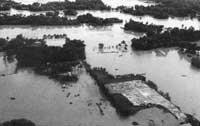The Royal Face of hosts
2001/05/27 Mendiburu, Joana - Elhuyar Zientziaren Komunikazioa
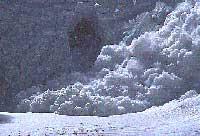
Saying "the sea is blue and wide" is not enough to clarify the history of ships and sailors that have disappeared over the years. But who dares to enter the Devil's Triangle or the mouth of the great waves? Until a few years ago nobody.
"Wall of water without foams and without summits", "Great wave to cover the moon", "gigantic wave in the sea of oil", the surviving sailors of the belly of an indignant wave or terrible have lacked words to describe what lived. And it is not for less, in the calm sea, because leaving the threat of 35 meters of unnoticed wave is not a cough of the middle of the night of the goat. With these stories, fear of the sea has taken root and sailors who did not return home stayed in the stomach of the sea forever, not knowing how and why they died. These waves, for example, carried in 1980 the largest ship lost by the British fleet, Derbyshire, with a crew of 44 men and 157,000 tons of iron ore or, in 1997, the sailboat of Gerry Rouf that participated in the Vendée Globe.
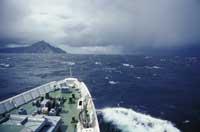
But the sailors are not the only ones who have suffered the terrible consequences of the waves. The oil platforms located in Norway or in the Shetland Sea also suffered serious damage and finally these waves, in addition to generating respect, have aroused curiosity for research. The interests of oil companies are great (it seems more important than the life of the sailors) and, in the last four years, scientists try to answer a series of questions about the waves. In November 2000, Ifremer (Institut Français de la Recherche pour l’Exploitation de la Mer) brought together giant wave experts and organized the first symposium of the French Brest for the exchange of information. The questions are many, but if we know when, under what conditions, where and how they arise, many problems could be avoided and many lives saved.
There are several theories to explain the formation of these waves, but according to the most advanced, the waves of 30 meters are generated when two strong marine currents collide. It is a phenomenon that occurs mainly in South Africa, on the coast of Florida, in the Gulf of Alaska and in southeast Japan, but it seems that it can be found anywhere with a wave of these characteristics, which have proven to be great travelers, regardless of their origin. For example, the large waves that break in southwest England originate 10,000 kilometers from southern Africa.
Therefore, even if it is not a stormy time, boats are always in danger of encountering such waves. However, experts are clear that storm times are the most dangerous, as in these cases they face three consecutive waves, which is almost impossible.
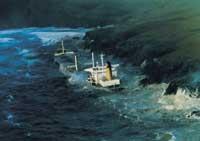
Much remains to be done, but experts agree to point out the importance of specific weather forecasts. The creation of a new information exchange network will serve to identify the generation of these waves and, thus, reports will be prepared to publicize the weather alert within approximately four years.
But these waves are not the only enemies of the sea found by sailors. In fact, more than one ship has disappeared without a trace as a submarine monster has swallowed it. Sailors from all over the world know well, for example, the Bermeo Triangle or the Devil's Triangle on the Scottish coast.
On December 5, 1945, a U.S. navy plane had to pose on the sea and disappeared for unknown reasons. The myth of the Bermuda Triangle arises from sci-fi stories and writings about this event. The most sensible theory was presented by geochemist Richard MacIver and geologist Bill Dillon. In his opinion, the cause of this disappearance is the methane emerging from the seabed. Recently, research in the Devil's Triangle has confirmed this theory.

In the area called Devil's Triangle is the crater called Hole of the Witch, 3 meters deep and 120 by 90 meters surface. Seismic data indicate that under the Witch Hole there are bags of methane. Methane arises as a consequence of the decomposition of organic matter that accumulates under the Earth's crust and after thousands of years passes from failures to the surface. The problem occurs when excessive internal pressure cracks the bag of methane and gas escapes as a group of bubble mists. In fact, normally, the mass of water that ships move is greater than that of the boat, so the boat is dragged by water.
But when water is replaced by gas heads, in this case methane, the containment force is lost. When the bubbles are rare, the boat can find the balance again, but when they are many, the boat gets into a kind of hole. Minutes later, the water covers the hole, the boat is filled with water and a vertical shipwreck occurs. This has been demonstrated by models and the geological and seismic studies carried out in the Bermuda Triangle and the Devil's Triangle have confirmed that methane is responsible for the disappearance of ships in these places.
Thus, to the detriment of storytellers of myths and tales, scientists are discovering mysteries on the high seas. The only penalty is that the events that have caused the death of so many sailors have been revealed to guarantee the interests of the oil companies.
Atlantic waterfalls
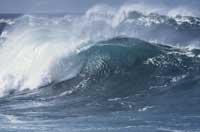
Where are the biggest waterfalls? In Brazil? In Venezuela? No, in the sea! The waterfalls on Earth are negligible compared to those on the sea. For example, a drop of water jumps 3.5 kilometers in the intersea waterfall of Denmark, while in the largest waterfall of the earth, Venezuela, that is, just one kilometer. They fall between 2.5 and 5 m3 of water per second in the Strait of Denmark and 1 m3 in that of Venezuela.
But how can there be waterfalls in the sea? How does water fall into water? Although it seems difficult to understand, just consider the degree of salinity and the temperature of the water. The water mass with a high degree of salinity is placed under the water mass with a lower degree of salinity, while cold water is always under hot water.
For example, Mediterranean waters have a high degree of salinity and cross the Strait of Gibraltar, encountering the waters of the Atlantic, but they do not mix too much. The Atlantic waters are less salty, so the Mediterranean waters are poured at 1,000 meters under the submarine slope.
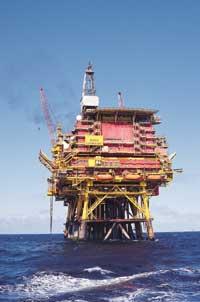
The water jump in Denmark is due to a temperature change. Submarine vultures from Norway and Greenland travel to the Strait of Denmark. At this point, they enter the Atlantic in a jump of 2.000 meters of height and 200 meters of width, to finish to 3.500 meters of depth.
On the other side of the world, the waters of Antarctica slowly rise to the equator to the waterfall of Ceuta (Brazil). This time it is the south that gives cold water to the north.
The formation of underwater waterfalls therefore requires that two bodies of water with different temperatures or salinity levels meet each other, but also that there is some impact on the relief. For example, the central folding of the Atlantic separates the east and west waters. Western waters are heavier than Eastern waters, so they tend to pass east through the slits found by Western waters, such as Romanche fracture.
These are the four largest Atlantic waterfalls, but there are also others in the Indonesian Strait.
Published in the supplement Natura de Gara.

Gai honi buruzko eduki gehiago
Elhuyarrek garatutako teknologia





